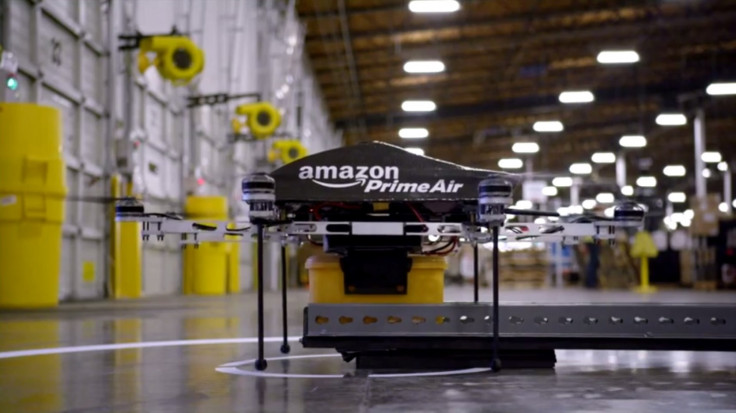What Happened To Amazon's Drone Delivery? Failures Occurring 'Every Day' Block Bezos' 10-Year Dream
KEY POINTS
- The "higher-ups went into war-room mode," a former employee said of the botched demo
- FAA officials who attended the demo reportedly smiled as the first drone failed to boot
- The FAA has many restrictions that held back Bezos' ambitious drone delivery dream
Amazon executive chairman and founder Jeff Bezos spoke in 2013 about his dreams of delivering customer orders through drones, but almost a decade in, multiple stumbling blocks keep this dream from being realized. A new report has even revealed how failures occurring "every day" led to a failed demonstration in Lockeford, California, in December 2022.
A former employee belonging to the Amazon Prime Air team that led the demonstration said "panic started to set in" when the software of the drone — which was supposed to carry a flight package in front of Prime Air chief pilot Jim Mullin, Amazon engineers and other staff and officials from the Federal Aviation Administration (FAA) — failed to boot, Wired reported Tuesday.
The "higher-ups went into war-room mode," the former employee who spoke on condition of anonymity out of fear of retaliation, told the outlet.
The former worker also revealed that the demonstration, which reportedly happened in front of about 40 people three days before Christmas, took about three hours to be completed because a second drone was needed for the show.
However, the second drone also ran into a technical glitch due to a misplaced marker that the package-carrying drone was aiming at for dropping at a customer's yard. A flight crew member who was on the scene said FAA officials were "smiling" while Prime Air leaders "were quietly fuming," according to the outlet.
Amazon picks California town Lockeford as the first to receive drone deliveries https://t.co/Y2qeELNGHX pic.twitter.com/0FZLlyVFnU
— Reuters Business (@ReutersBiz) June 15, 2022
The botched delivery attempt was "really disheartening," the former employee also recalled before saying, "But it wasn't unexpected. We had failures almost every day."
While the FAA cleared Prime Air for delivery testing in December after years of discussions, Amazon's drone delivery still needs to complete a set of hours of flying without any incidents. Data from the flying hours should be submitted to the agency and the FAA will review the data before it approves commercial deliveries, CNBC reported.
There are only two locations where the FAA is allowing drone delivery: College Station in Texas and Lockeford in California. Government records showed that there were still restrictions from the aviation regulator even in the said areas, as per the outlet.
Employees told CNBC last month that Prime Air's Lockeford facility could only deliver to two homes due to some FAA restrictions. There was "more work to do and less clarity on their parent company's ongoing commitment to the mission," the outlet noted.
About a month after getting the necessary clearance from the FAA, Prime Air only served fewer than 10 households, The Information and Insider reported in February. The Information disclosed that the aviation regulator rejected many of Amazon's requests for loosened safety rules in 2022.
Meanwhile, some employees raised safety concerns after a series of crashes at one test site, according to Insider. One of the crashes triggered a 25-acre brush fire, employees reportedly claimed. Some of Prime Air's safety teams were also among the hardest hit in Amazon's mass layoffs.
Amazon spokesperson Maria Boschetti told Insider in response to safety-related allegations that "many of the allegations in this story are misinformed or inaccurate."
Boschetti also claimed that there was a "dedicated safety officer in each location" and dozens of other employees dedicated to safety.
Early in December 2013, then-CEO Bezos unveiled his dreams of drone delivery in 60 minutes. The billionaire said at the time that the goal was a "half-hour delivery" and the launch would be within four to five years.
In 2013, Jeff Bezos called his shot:
— Brandon Arvanaghi 🐱 (@arvanaghi) January 2, 2023
"Amazon delivery to your door in 30 minutes".
How?
Drones.
Jeff thought it'd take 5 years.
It took 10.
But it's finally here.
This week, Prime Air is live in California and Texas.
Long-term thinking connects all world-class companies. pic.twitter.com/KHl4xZZ6PH
Almost a decade after Bezos thrilled the world with his ambitious Prime Air reveal, the team still has some FAA "ground rules" to follow, some of which prevent the dream from moving forward, as per The Verge.
Among the many prohibitions are "overflight of power plants," flying drones over people and over schools and overflight in areas deemed as "high risk." The FAA also made it clear that Amazon should explicitly inform customers not to stand in their own backyards when their packages are being delivered.
Boschetti told the outlet that the FAA has approved deliveries to more customers in the two locations late in January of this year and that Prime Air continues to work on its next-gen drone.
Amazon Prime Air made its first drone delivery in 2016, but the succeeding deliveries were held back by crashes during product testing.
Ahead of the Lockeford demonstration, Amazon said its drones were able to avoid people, animals and other obstacles to make sure the package arrived without damage.

© Copyright IBTimes 2025. All rights reserved.






















